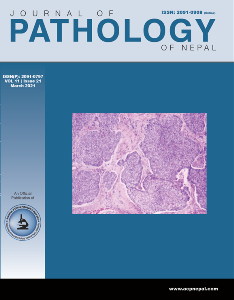A study of histomorphology and immunohistochemistry of papillary squamotransitional cell carcinoma: A rare variant of squamous cell carcinoma of cervix.
DOI:
https://doi.org/10.3126/jpn.v11i1.32820Keywords:
Cervix; Cytokeratin7; Cytokeratin20; Papillary squamotransitional cell carcinoma;Abstract
Background: Papillary squamotransitional cell carcinoma is a histopathological subcategory of squamous
cell carcinoma of the uterine cervix that often resembles transitional cell carcinoma of the urinary tract.
Histologically, it can be misdiagnosed as transitional cell carcinoma or other papillary lesions of the
cervix. Stromal invasion on biopsy is difficult to diagnose due to the exophytic papillary growth of the
tumor. It also has a propensity for local recurrence and late metastasis. The study is performed to diagnose
and categorize this uncommon variant of carcinoma cervix.
Materials and Methods: Eighteen cases of Papillary squamotransitional cell carcinoma were diagnosed
on a punch biopsy specimen on routine hematoxylin and eosin-stained sections. The tumors were
categorized into three groups according to the percentage of squamous and transitional components.
Further, immunohistochemical evaluation for cytokeratin7 and cytokeratin20 was done.
Results: The mean age of the patients was 51.61 years (range 37-62 years). The most common clinical
presentation was postmenopausal bleeding. All the cases showed papillary architecture with fibrovascular
cores. The papillae were lined by three cell types: clear, intermediate, and basaloid. Stromal invasion
was seen in all the cases. All the cases showed positive immunostaining for cytokeratin7 and negative
immunostaining for cytokeratin20.
Conclusions: Papillary squamotransitional cell carcinoma deserves accurate pre-operative biopsy
diagnosis due to the risk of misdiagnosis as benign papillary or malignant transitional lesions.
Immunohistochemistry plays an important role in the diagnosis of these tumors and is recommended in
every case. Late recurrence and metastasis warrants a longer duration of follow up.
Downloads
Downloads
Published
How to Cite
Issue
Section
License
This license enables reusers to distribute, remix, adapt, and build upon the material in any medium or format, so long as attribution is given to the creator. The license allows for commercial use.




